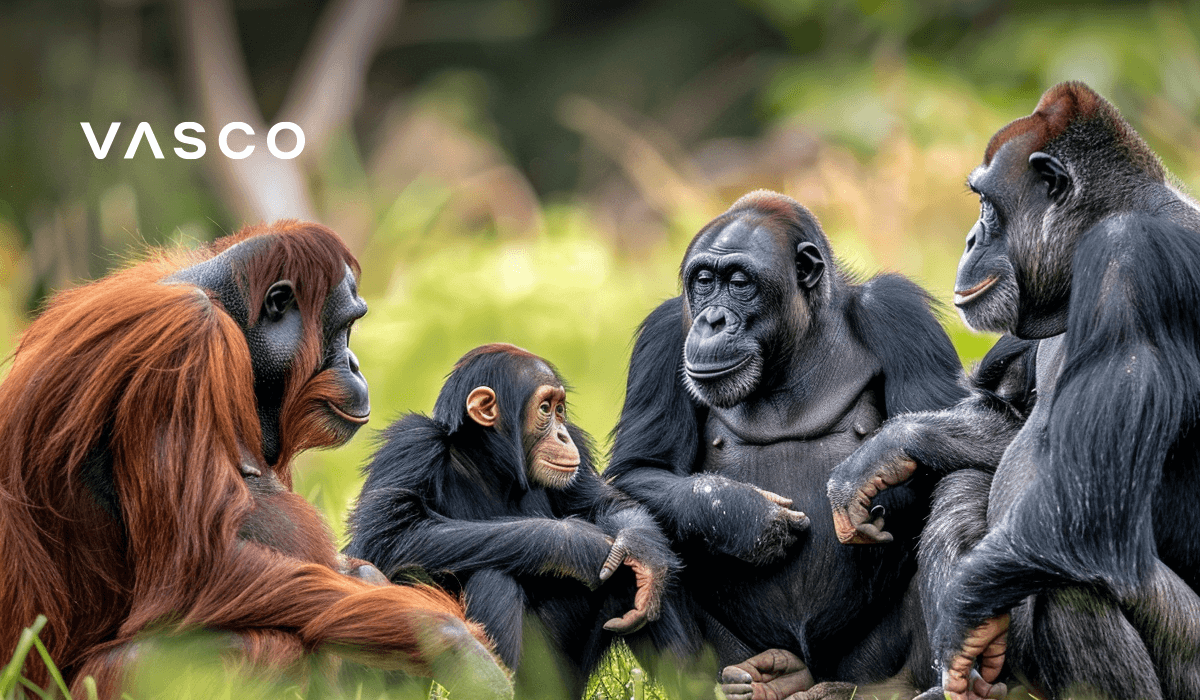Primate communication has evolved significantly over millions of years, leading to increasingly complex signals that make social coordination and survival much easier.
Table of Contents:
Research on great apes, including Koko, Nim Chimpsky, and Kanzi, demonstrates their remarkable capabilities in language learning and highlights the depth of their cognitive abilities.
But why even research that? Well, understanding primate communication provides valuable insights into the origins of human language and emphasizes the evolutionary connections between primates and humans.
FAQ:
Can apes theoretically talk?
What is the language of the mangani?
Is it possible for an ape to speak a language?
Who is the chimpanzee in Planet of the Apes?
Do the apes speak English in Planet of the Apes?
Why can’t humans talk in Planet of the Apes?
The Evolution of Primate Communication
Key Insight: Studying this evolutionary process offers valuable clues about the development of human language too!
Origins and Development
The journey of primate communication is a fascinating tale of adaptation and cognitive growth spanning millions of years.
- Timeline: Began millions of years ago
- Process: Gradual evolution in response to environmental challenges
- Correlation: Communication methods developed alongside cognitive abilities
- Driver: Need for social coordination and survival in dynamic ecosystems
Evolution of Communication Signals
Primate communication signals underwent a remarkable transformation, evolving from basic instinctual responses to complex, meaningful exchanges.
Primate communication signals evolved from basic processes to complex systems:
- Starting point: Simple physiological responses to stimuli
- Development: Ritualized abbreviations of behavioral and physiological processes
- End result: Elaborate signals understood by group members
These evolved signals serve multiple purposes:
- Indicate food availability
- Alert to potential threats
- Facilitate sophisticated social interactions
Key Advantage: As primates navigated their environments, these evolved signals provided a critical edge for survival and social cohesion.
Significance for Human Language Research
The study of primate communication offers a unique window into the origins and development of human language.
Research Impact: By examining primate communication, we gain a better understanding of the evolutionary pathways that led to our own sophisticated language abilities.
This approach to studying primate communication provides a framework for comprehending the intricate relationship between cognitive development, environmental pressures, and the emergence of complex communication systems in both primates and humans.
Language Learning in Great Apes
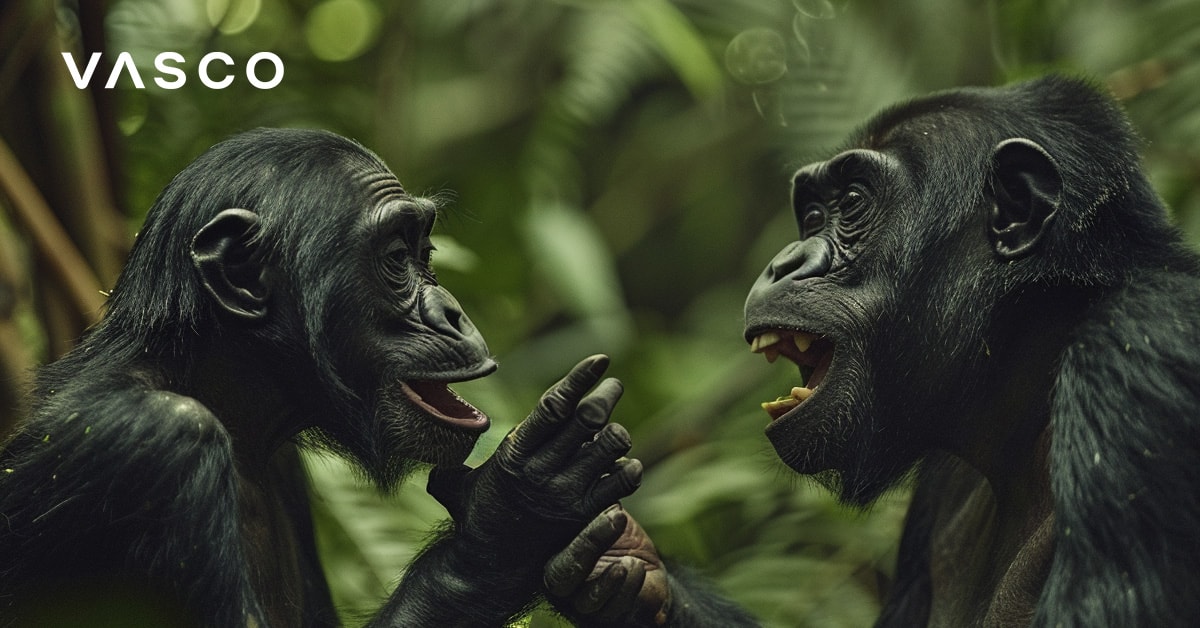
Great apes have demonstrated remarkable capabilities in learning human languages through various innovative methods.
Researchers have trained these intelligent beings using sign language, physical tokens, and lexigrams, revealing their impressive cognitive abilities.
- One of the most notable examples is Kanzi, a bonobo who acquired a substantial vocabulary and showed an understanding of grammar and syntax, similar to how human children learn language. This challenges the traditional view that language is a uniquely human trait.
- Kanzi’s abilities are not an isolated case. Koko the Gorilla was taught both verbal words and American Sign Language, enabling her to use hundreds of signs to communicate her thoughts and feelings. These cases highlight the potential for non-human primates to grasp aspects of human language, making us reconsider the boundaries of animal cognition and communication.
Research controversies
Critics argue that the communication skills of apes like Koko and Nim Chimpsky may be more a result of operant conditioning rather than true language acquisition.
Despite this, the evidence of their ability to use signs and symbols meaningfully cannot be dismissed. These findings underscore the complexity and depth of how primates communicate.
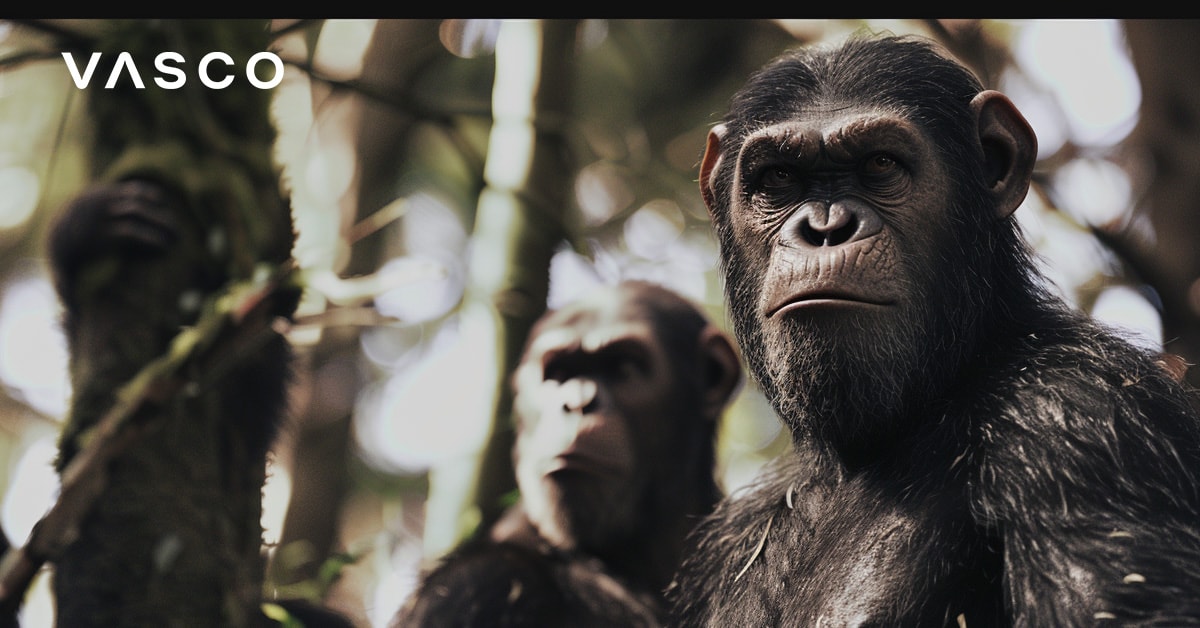
Kingdom of the Planet of the Apes Franchise
While our exploration of real-world ape communication offers fascinating insights, the realm of science fiction provides an intriguing take on the evolution of primate language.
In the Planet of the Apes franchise, the concept of ape language is taken to new heights, offering a speculative glimpse into what advanced simian communication might look like.
What is the language in the Kingdom of Apes?
In the series, particularly the reboot films (2011-2017), the apes use a combination of vocalizations, sign language, and eventually spoken English to communicate.
This fictional evolution of ape language parallels some of the real-world research we’ve discussed, such as the use of sign language by Koko the Gorilla and Nim Chimpsky. However, the franchise takes this concept further, imagining a world where apes develop the ability to speak human languages.
The apes’ initial communication in the films relies heavily on sign language, mirroring real-world experiments with great apes. As the apes evolve and gain intelligence due to a human-created virus, they begin to develop more complex forms of communication. This progression from gestures to spoken language in the films reflects the hypothetical evolutionary path of human language development that researchers have proposed.
What is the name of this language?
Interestingly, the franchise doesn’t assign a specific name to the apes’ language. Instead, it portrays a gradual transition from primitive communication to the use of human language, primarily English.
This evolution is particularly evident in the character of Caesar, the protagonist chimpanzee, whose linguistic journey from sign language to spoken English serves as a central element of the narrative.
The depiction of ape language in the Planet of the Apes franchise, while fictional, encourages us to consider the potential for advanced communication in our primate relatives. It serves as a thought-provoking extension of the real-world research into ape communication, inviting us to imagine the possibilities if the cognitive and physiological limitations we’ve discussed were overcome.
Mimicking Human Speech: A Comparative Analysis
The ability to mimic human speech has long been considered a unique human capability, but recent studies have begun to challenge this notion.
Rocky, an orangutan, has astonished researchers with his ability to mimic human speech, producing vowel and consonant sounds and combining them into syllables. This vocal mimicry showcases a level of vocal control and flexibility that was previously thought to be beyond the reach of non-human primates.
Despite these impressive abilities, other primates face significant anatomical limitations that prevent them from fully replicating human speech. Their vocal tracts lack the necessary structures to produce the wide range of sounds that humans can.
However, Rocky’s ability to control the tone and pitch of his vocalizations suggests that the potential for speech-like communication exists in these species. This finding offers valuable insights into the origins of human speech and may reshape our understanding of the evolutionary pathways that led to our own vocal abilities.
Rocky’s distinct vocalizations, known as ‘wookies,’ are unique sounds not typically associated with orangutans. These vocalizations provide a fascinating glimpse into the vocal capabilities of primates and highlight the complex nature of their communication systems.
By studying cases like Rocky, we can better understand the evolutionary roots of human speech.
The Role of Gestures in Primate Communication
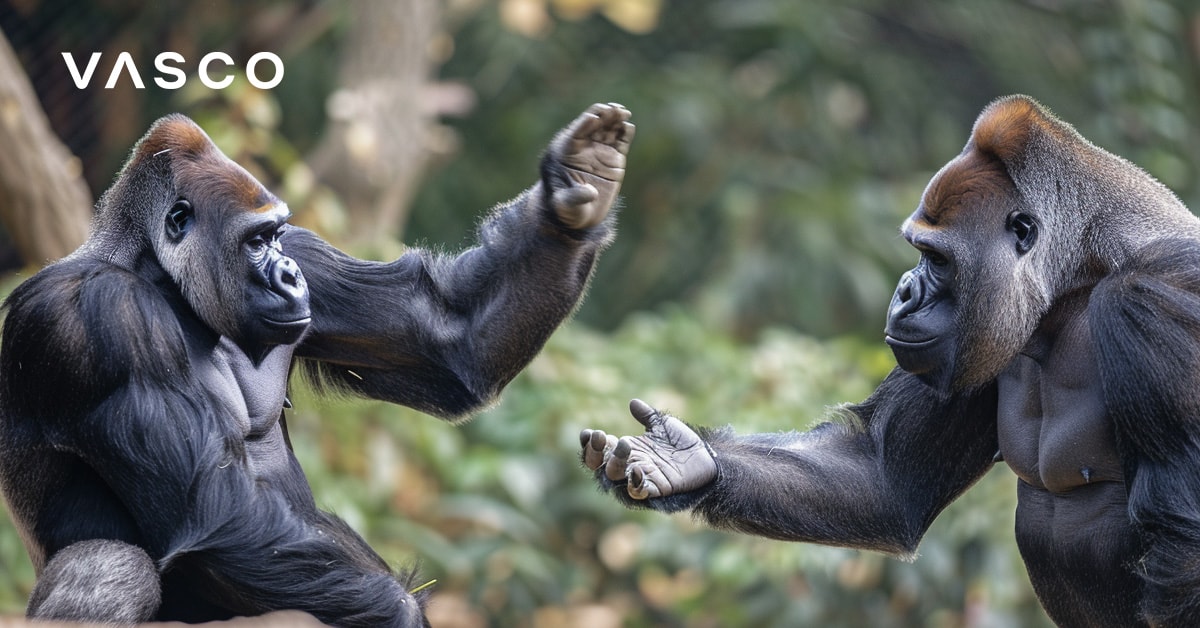
Gestural communication plays a pivotal role in the social interactions of great apes.
These gestures are not merely instinctual but can be adapted based on social learning and specific contexts.
Primate communication encompasses a diverse array of vocalizations, gestures, and facial expressions, each serving as a sophisticated form of social signaling. This blend of communication methods allows primates to convey a wide range of emotions and intentions.
The gestural communication systems of great apes are extensive and include many shared gestures across different species. These gestures often carry intentional meanings, reflecting the advanced cognitive abilities of these animals.
Example: An ape might use a begging gesture to request food or initiate play, demonstrating their ability to use specific gestures for particular purposes. This intentionality underscores the complexity and depth of their communication systems.
Affiliative Behaviors and Social Signaling
Gestures in primate communication are not only used to convey desires but also play a crucial role in social interactions.
These affiliative behaviors help initiate and regulate play, establish social bonds, and maintain group cohesion.
Example 1: Male ring-tailed lemurs engage in ritualized interactions, known as stink fights, to establish social hierarchy during mating. These behaviors highlight the importance of gestures in maintaining social structures within primate groups.
Example 2: Female ring-tailed lemurs usually dominate social interactions, influencing their aggressive behavior towards males and other females. These social dynamics are reflected in their communication patterns, demonstrating the complex interplay between behavior and communication in primate societies.
Case Studies: Famous Primates and Their Communication Skills
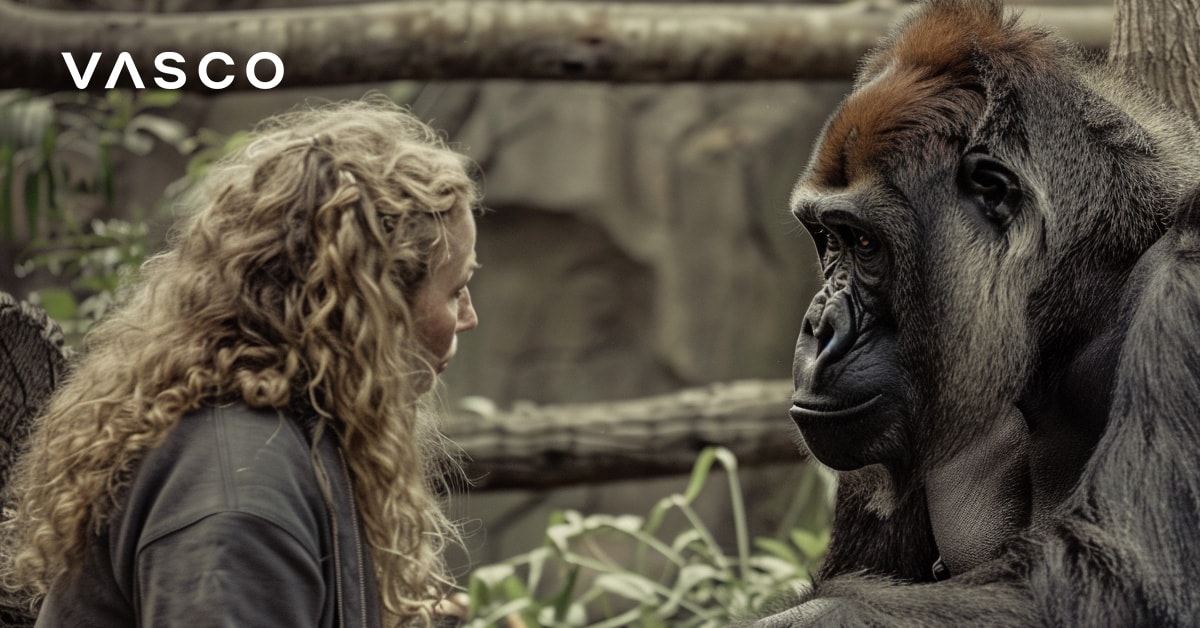
We have already mentioned them before, but let’s dive deeper into those case studies!
Koko the Gorilla
Koko the Gorilla is perhaps the most famous example of a primate using sign language. Taught to use American Sign Language, Koko was able to communicate her thoughts and feelings, using hundreds of signs to express herself. However, her abilities have sparked debates, with some critics arguing that her random utterances were dubiously interpreted by her interpreter. Despite these controversies, Koko’s achievements cannot be overlooked.
One of the most notable moments in Koko’s life was her message concerning climate change, which was released in a video by the Koko project. This highlighted her ability to use language to convey complex ideas, further emphasizing the potential for primate communication.
Koko’s life and abilities continue to inspire and challenge our understanding of animal cognition.
Nim Chimpsky
Nim Chimpsky is another well-known primate who was studied for his communication skills, particularly in sign language. Taught more than 100 signs, Nim’s longest recorded sentence consisted of sixteen words, showcasing his ability to combine signs meaningfully. However, his abilities have also sparked debates on the true nature of language acquisition in primates.
Terrace’s seminal 1979 article highlighted the complexities in studying primate communication, observing that Nim often mimicked human behavior rather than demonstrating a true understanding of language. This challenged previous assumptions about ape communication and continues to influence research in the field.
Kanzi the Bonobo
Kanzi the Bonobo is renowned for his ability to understand spoken English and use lexigrams to communicate meaningfully. He learned to point to symbols representing about 350 words, demonstrating a remarkable grasp of human language aspects. Kanzi’s achievements have provided significant insights into the cognitive abilities of great apes and their potential for language learning.
At 41 years old, Kanzi continues to be a prominent figure in primate communication research, challenging our understanding of the boundaries between human and animal cognition.
Implications for Understanding Human Communication
Research on primate communication offers valuable insights into the development of human language. These studies reveal intriguing connections between primate and human communication systems.
Key findings:
- Vocal learning in primates suggests a shared genetic basis for vocalization
- The ability to use signs and symbols can extend to novel combinations in primates
- This ability is similar to how humans form new phrases
These discoveries could reshape our understanding of language capacity across species.
The Chimpanzee and Human Communication Institute has made significant contributions to this field. Their research indicates that chimpanzees can:
- Refer to categories
- Create novel signs
These abilities align chimpanzee cognitive skills with early human language development, highlighting shared evolutionary pathways between humans and primates.
However, there are important distinctions to consider:
- Great apes possess the physical tools for vocalization
- They lack the intrinsic motivation that humans have to connect voices with thoughts
This difference underscores the unique aspects of human communication. At the same time, it emphasizes the potential for understanding the evolutionary roots of our language systems through primate studies.
By exploring these similarities and differences, we can gain a deeper understanding of how human language evolved from our primate ancestors’ communication systems.
Conservation and the Future of Primate Communication Research
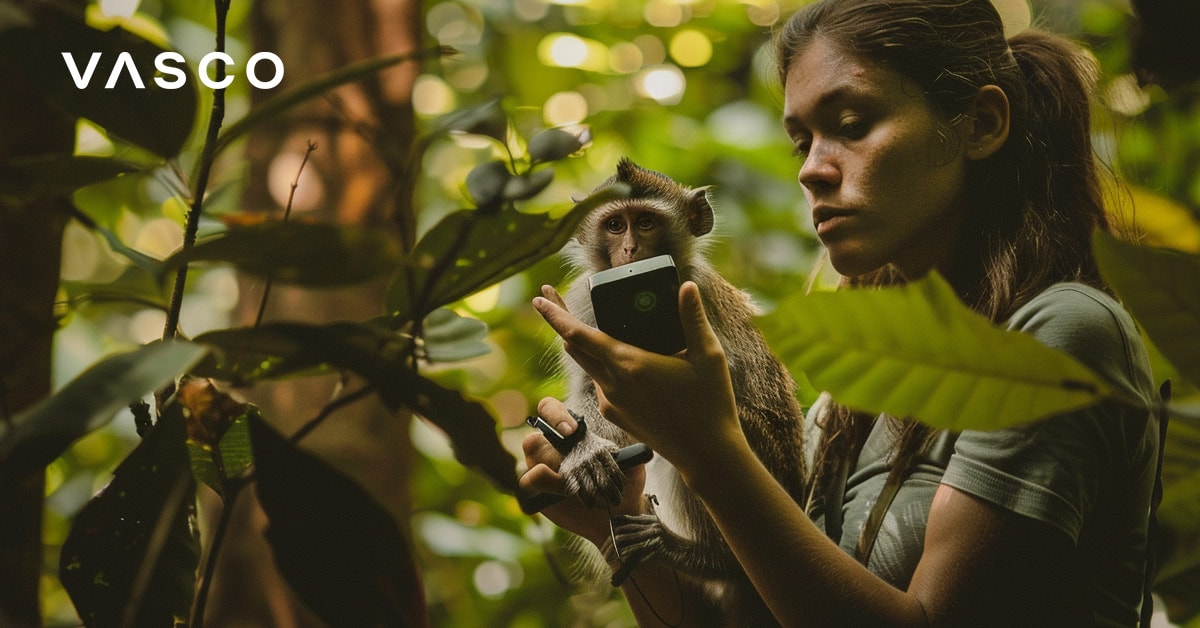
Climate change poses significant challenges for primates, altering their habitats and affecting their communicative behaviors. Conservation efforts are crucial to protect primate habitats, supporting the natural communication systems that species rely on. Understanding the interplay between climate factors and primate communication is essential for developing effective conservation strategies.
Future research should focus on understanding the effects of environmental changes on primate communication patterns and the implications for species survival. By addressing these challenges, we can ensure the continued study and protection of these remarkable creatures.
Summary
As we continue to explore the Kingdom of the Planet of the Apes, we gain a deeper appreciation for the intricacies of animal communication and its implications for understanding our own language systems. The journey of discovery is far from over, and the insights gained from these studies will undoubtedly continue to inspire and challenge us.
Are you interested in languages in general? Be sure to check out our universal translator. It makes it possible to understand over 90% of world’s population! You can use features such as voice translator, photo translator and even language learning app. Who knows, maybe some day it’ll translate the language of apes too! 🙂
